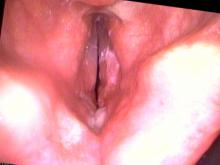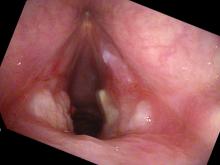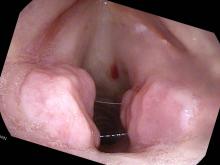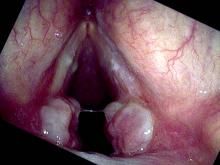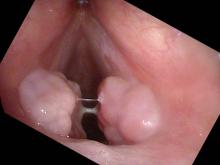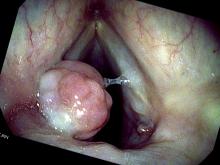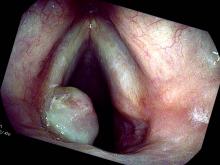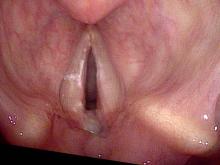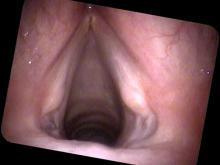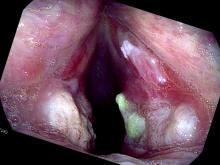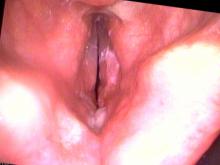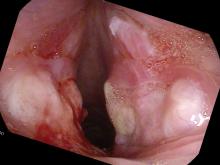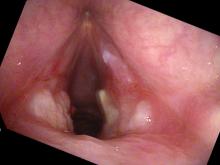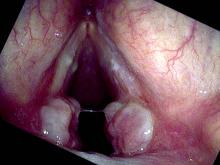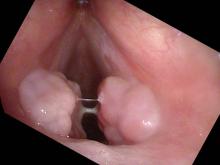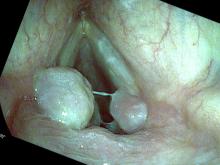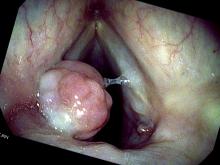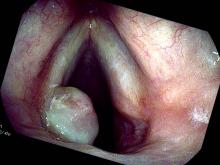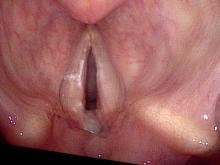Intubation vocal cord granulomas
Granulomas are wound healing lesions. They occur as a result of trauma which denudes the mucosa and exposes the underlying tissue to the bacteria of the throat. They typically start off life as an ulceration and are associated with pain frequently. It is the type of pain that you might experience when you bite your tongue or cheek, so it has a sharp quality. The granuloma is a collection of capillaries which are hypertrophic. The granuloma starts out flat and then gradually forms a sphere on a stalk. This is part of the healing process as the mucosa grows underneath the granuloma. Eventually the granuloma decapitates or falls off. Depending on the cause of the granuloma, management can vary. In this case, the trauma was from an endotracheal tube left sitting between the vocal cords in the throat for several days. While granulomas can form anywhere in the larynx, the mucosa overlying the vocal process of the arytenoids has almost no cushion. It is the most frequently injured mucosa and granulomas are most weekly found at the back of the larynx over this cartilage.
Because of a complication during a cardiac catheterization, this man was intubated for 5 days. He was hoarse afterwards and on his initial examination 2 weeks after the tube had been removed he had an ulceration behind the vocal process on both sides and along much of the length of the right vocal cord.
2 weeks after injury
This is a false color image which highlights blood vessels. You can see the raw ulcer on the right over the vocal process as well as an ulcer on the right vocal cord. There is a great deal of blood surrounding this area.
When he closes the vocal cords together to make sound, they are very stiff and do not vibrate well. Consequently air leaks between them and he has a husky hoarseness.
His cricoarytenoid joints were also stiff as this was the maximum that he could open his vocal cords.
His cricoarytenoid joints were also stiff as this was the maximum that he could open his vocal cords.
I injected the granulomas with triamcinolone 2 weeks after they formed to see if that would speed along their maturation. I'm not sure that it changed the course a great deal. He ultimately formed 2 granulomas behind the left vocal process and one on the right.
3 weeks after injury
Granulomas are forming where the ulcers originally were present.
4 weeks after injury
The granulomas began to mature and become more of a sphere.
The granulomas began to mature and become more of a sphere. The surface becomes more white. The ulcer is still present on the right vocal cord.
2 months after injury
The granulomas continue to mature. His voice is actually getting more husky because the size of the granulomas prevents the approximation of the vocal cords. The right vocal cord ulcer is still present.
3 months after injury
A portion of the right granuloma has fallen off.
5 months after injury
After that the treatment was just watching and waiting. At 5 months, the right granuloma fell off.
The right granuloma has fallen off and there is only a nubbin of blood vessel tissue where the stalk used to be. The right vocal cord ulcer has healed although the vocal cords are still a bit stiff.
6 months after injury
At 6 months, one of those left-sided granulomas fell off. His voice improved.
Only one granuloma remains on the left side.
The left granuloma slides underneath the right vocal cord when he tries to make sound.
8 months after injury
At 8 months, the remaining left granuloma fell off and his voice returned to normal. There is still a tiny nubbin on the left side. Many times this type of injury results in a contraction of the tissue in this area pulling the vocal cords towards the middle. He did not have this problem.


